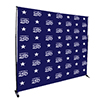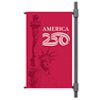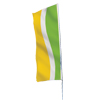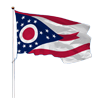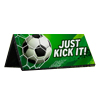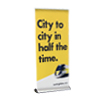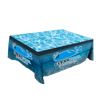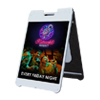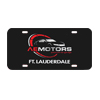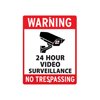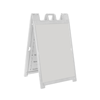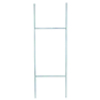ART REQUIREMENTS
1. Software Supported We can output digital files from the following software products: Adobe Illustrator CS6, Photoshop CS6, InDesign CS6, and Medium Resolution PDF files. If you are using a newer version than what is listed, please save your document as an earlier version that is compatible with our software versions listed. If the software you are using is not on this list, please contact us as some programs can save files in an PDF or JPEG format that may be acceptable for output.
2. Setting up your document Please build one file per design. In the case of programs that support multiple pages only place one design per page. Color mode should be CMYK, not RGB. All colors used in document must be specified as CMYK, not Spot colors. Create your document to actual size, with the dimensions in inches, NOT feet. (For example, if your final product is 3’ x 5’, build it as 36” x 60”.) For banners and flags, inset your text and important graphics 2.5” from the edge to prevent them from being sewn through in the finishing process. Please remember to save a copy of your file with the type converted to outlines, paths or curves and send us this copy to prevent any font substitution problems.
3. Resolution for Bitmap / Digital Images When including Photoshop (bitmap) images, you should scan or create your image at its final reproduction size at the following resolutions:
75-100 pixels per inch for vinyl banners
100-120 pixels per inch for textile printing
150-220 pixels per inch for rigid substrates
Rasterized type in Photoshop will lose its crisp look and ‘stair-step’ if the file resolution is too small. Save these files in the JPEG format with the quality or compression level set to Highest Quality or Maximum Quality. This setting ensures there is no distortion or loss of detail while providing the best compression of the file.
4. Color Matching If color is critical to your job, for additional charges we can produce a small print sample of your file for you to inspect. Color corrections can then be made and another print sample made for final approval. If you specify pantone spot colors, our color management will attempt to get as close as possible, however this may result in a color that does not look as you intended. Due to the nature of digital imaging, exact Pantone spot color matches are not always possible. For an additional fee we can provide you with a printed color chart so you can see how your Pantone spot colors will print. Please note that metallic inks are not available for digital printing. Pantone’s CMYK equivalent will be substituted for the metallic inks specified in your file. If you do not wish this substitution to occur, please substitute a non-metallic color to simulate the effect you are trying to achieve.
5. Hem and Trim Allowances Banners – Our standard hem turns 1.125” of material (add 2.25" to your required finished size) and is double stitched with the stitching coming in 3/4” from the folded edge. A 2.5″ margin from the (2.25" oversized) unfinished trim edge of the banner is required to prevent Live content from being turned and sewn.
POCKETS: Pole pockets are calculated based on the outside diameter of the pole. Up to 1” pole diameter would use a standard 3” pocket that has a 2.25” opening (measured flat). 1.25” – 1.875” Poles would use a 4” pocket that has a 3.25” opening (measured flat). Please request a template for banners that require pole pockets to help prevent your live content from being sewn through.
HORIZONTAL FLAGS: Our standard hem for Horizontal Flags turns 0.75” of material and is Double Stitched along the top and bottom edges with the stitching coming in 3/8” from the folded edge. The Fly edge of the flag is Quad stitched and turns 2” of material with the stitching coming in 1.5” from the folded edge.
VERTICAL FLAGS: All Vertical Flags are Quad Stitched along each of the three (non-header) sides of the flag.
MARGINS: Double Stitched sides require a 1.5″ margin from the unfinished trim edge to prevent Live content from being turned and sewn. Quad Stitched sides require a margin of 2.5” – 3” from the unfinished trim edge. The canvas header covers 1.5” of the left hand side of the flag, so a margin of 2” from the header’s unfinished trim edge is required.
POCKETS: Pole pockets are calculated based on the outside diameter of the pole. Up to 1” pole diameter would use a standard 3” pocket that has a 2.25” opening (measured flat). 1.25” – 1.875” Poles would use a 4” pocket that has a 3.25” opening (measured flat). Please request a template for banners that require pole pockets to help prevent your live content from being sewn through.
Rigid Signs – Our rigid sign process requires no special allowances except in cases where special frames are used for mounting. Please be sure to consult with us on Rigid sign requirements BEFORE you invest a lot of time into artwork creation.
6. Try one of our templates Our templates are the best way to minimize production delays. They are created to the exact dimensions of the product you are ordering and include guides to show the live area, bleed and allowances for trimming and hemming. If you do not see the template you are looking for call us and we will happily provide you what you need. If you need further clarification, please contact us.
FILE SUBMISSION GUIDELINES
Save a Copy of your file(s) with the type converted to outlines, curves or paths. (Illustrator, Freehand, InDesign and CorelDraw all have this capability.)
If you cannot convert your type to paths, curves or outlines, then please include the fonts (both outline/printer and screen/bitmap files) or Font Substitution will occur and your file will not output properly.
Include all the files you placed into your artwork. Embedding files is not recommended as it invites file corruption and often embedded files will not output properly.





